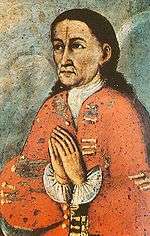Mateo Pumacahua

Mateo García Pumacahua (September 21, 1740 – March 17, 1815) was a Peruvian revolutionary that led the Cuzco Rebellion of 1814 in the War of Independence.
Biography
Pumacahua was the cacique of Chinchero, brigadier of the militia of the Viceroyalty of Peru, and interim president of the Audiencia of Cuzco. Pumacahua was a member of the Inca nobility of Ayarmaca descent,[1] who also has some Spanish ancestry.[2] Pumacahua helped defeat the rebel army of Túpac Amaru II in 1781, an event depicted in a mural at the church of Chinchero.
Three decades later, despite being in his seventies, Pumacahua led indigenous militias in the expeditions viceroy José Fernando de Abascal sent against the junta of La Paz in Upper Peru during 1811. Despite having won the battle of Guaqui as colonel of the Royal Army, he joined the insurrection of central and southern of viceroyalty of Perú (Cuzco, Huamanga, Arequipa and Puno) started in Cuzco on August 3, 1814, demanding the full implementation of the Spanish Constitution of 1812 in Peru. Pumacahua was appointed member of the governing junta. Pumacahua led the forces that occupied Arequipa on November 10. On November 30, Pumacahua's troops retreated from Arequipa to the Cuzco and Puno regions. On March 11, 1815, Pumacahua and his troops were defeated in the battle of Umachiri. He was captured and executed in May by the royal army.[3]
See also
References
- ↑ Cahill, David Patrick; Blanca Tovías (2006). New World, First Nations: Native Peoples of Mesoamerica and the Andes Under Colonial Rule. Sussex Academic Press. p. 186. ISBN 1-903900-63-8.
- ↑ Nicholson, Irene (1969). The Liberators: A Study of Independence Movements in Spanish America. Praeger. p. 137.
- ↑ Lynch, John (1986). The Spanish American Revolutions 1808-1826 (2 ed.). London: W. W. Norton & Company. pp. 165–170. ISBN 0-393-95537-0.